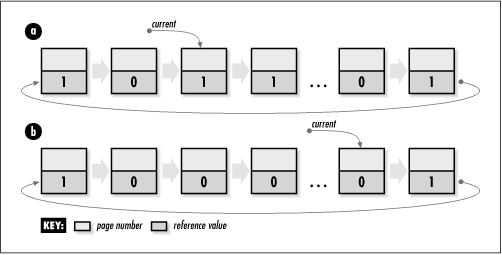Circular List Example: Second-Chance Page Replacement
Earlier we saw how a singly-linked list might be used to manage frame allocation in a virtual memory system. One issue not addressed, however, was how a system allocates new frames when the list of available frames is empty. To deal with this, a system frees a frame by moving a page from physical memory to a disk called a swap disk. The system uses a page-replacement algorithm to determine which frame is best to free at a given moment. One example of a page-replacement algorithm is the second-chance algorithm, sometimes called the clock algorithm .
Ideally, it would be great if all pages of a process resided in physical memory at once, but usually this is not possible. Typically, many processes may be running on a system simultaneously, all competing for its physical memory. Sometimes even a single process may have such a large address space that it cannot fit itself into physical memory. Faced with having to replace a page at some point, then, it should seem reasonable that the best page for a system to replace is the one that it will not access for the longest time to come. However, since it can’t predict the future, a system sometimes uses an assumption that the past will be a reasonable indication of the future and replaces the page that has been accessed least recently. This is known as least recently used, or LRU, page replacement .
The second-chance algorithm is one approach to implementing an LRU page-replacement scheme. It works by maintaining a circular list of pages that are currently in physical memory. For simplicity, consider each element in the list to store only a page number and a reference value, which is set to either 1 or 0. In practice, each element contains other information as well. All pages initially have a reference value of 0. Whenever the page is accessed by the system (as in a process reading from or writing to the page, for example), its reference value is set to 1.
When a frame is needed, the system uses the circular list and the reference values it maintains to determine which page should give up its frame. To determine this, it moves through the list until it finds a reference value of 0. As it traverses each page, the system resets the page’s reference value from 1 to 0. Once it encounters a 0, it has found a page that has not been accessed by the system since the last cycle through the list; thus, it is the page least recently used. This page is then replaced in physical memory with the new page, and the new page is inserted in place of the old one in the list. If all pages have been accessed since the algorithm was last run, the system ends up making a complete cycle through the list and replaces the page at which it started.
The example here is an implementation of this page-replacement
strategy. It uses a function called replace_ page
(see Examples Example
5.8 and Example 5.9). The
function accepts a single argument called
current, which points to the element of a
circular list containing the page at which to begin searching (see
Figure 5.8). As the list is
traversed, the algorithm inspects the
reference member of the
Page structure stored in each element to determine whether
it is 1 or 0. If it is 1, it resets it to and goes to the next page;
if it is 0, it has found the page to replace. Eventually, if all pages
have been traversed, the circular nature of the list will land the
algorithm back on the page at which it began. This time the page’s
reference value will be (because it was reset when it was first
encountered), and it is returned as the page to be replaced. Upon
return, current points to the page at which
the search ended. This becomes the page at which to begin the next
time a frame is neededA circular list models this problem nicely
because it allows a system to cycle through pages just as the
algorithm requires. The runtime complexity of
replace_page is O
(n), where n is the number
of pages in the circular list. This is because, in the worst case, the
algorithm may need to make a complete cycle through the list to find
the page to replace. .
/*****************************************************************************
* *
* -------------------------------- page.c -------------------------------- *
* *
*****************************************************************************/
#include "clist.h"
#include "page.h"
/*****************************************************************************
* *
* ----------------------------- replace_page ----------------------------- *
* *
*****************************************************************************/
int replace_page(CListElmt **current) {
/*****************************************************************************
* *
* Circle through the list of pages until one is found to replace. *
* *
*****************************************************************************/
while (((Page *)(*current)->data)->reference != 0) {
((Page *)(*current)->data)->reference = 0;
*current = clist_next(*current);
}
return ((Page *)(*current)->data)->number;
}
/*****************************************************************************
* *
* -------------------------------- page.h -------------------------------- *
* *
*****************************************************************************/
#ifndef PAGE_H
#define PAGE_H
#include "clist.h"
/*****************************************************************************
* *
* Define a structure for information about pages. *
* *
*****************************************************************************/
typedef struct Page_ {
int number;
int reference;
} Page;
/*****************************************************************************
* *
* --------------------------- Public Interface --------------------------- *
* *
*****************************************************************************/
int replace_page(CListElmt **current);
#endif 
